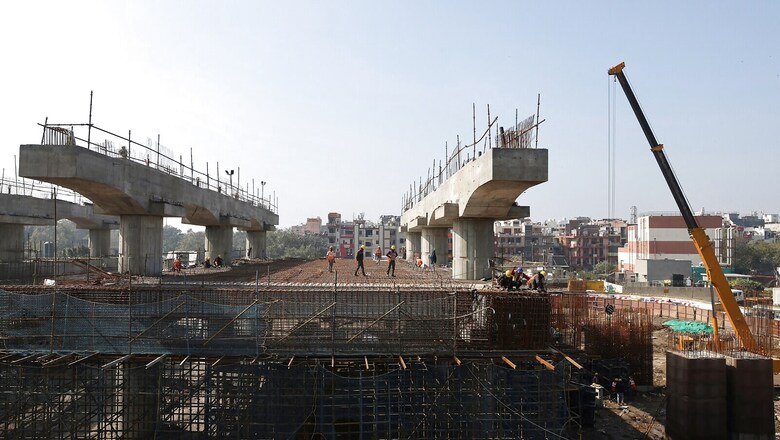
views
The Union Budget has rightly emphasised on the need for a thrust on infrastructure for growth. Capex has become the new buzz word for Indian Mandarins. As East Asian nations have demonstrated, human capital is also very central to the emergence of higher order skill and education-led economies.
India’s emerging opportunities may well be more in services sector and manufacturing relocating to smaller towns and rural areas, as small and medium enterprises. This important point should drive infrastructure.
The opportunity to every youth to develop their fullest human potential is necessary for economic progress. Social infrastructure of schools, hospitals, skill centres, Aanganwadis also need to be a part of the infrastructure push as our opportunities are going to be different – more services than manufacturing. Bringing down cost of logistics acquires even greater importance when production is dispersed.
I wrote a few months ago on why even infrastructure projects require a strong community connect. I had argued that timely completion with quality outcomes happens when local community own infrastructure initiatives, especially in the 29 sectors listed in the Eleventh Schedule for Rural Panchayats and in the 18 sectors listed in the Twelfth Schedule for Urban Local Bodies. While maintaining the thrust on infrastructure, it is important to recognise the following eight key pathways to a good infrastructure thrust.
1. Infrastructure projects must be prioritised on the basis of critical opportunity analysis with community connect. If we listen to research and citizen voices in time, it improves the planning and outcome of an infrastructure project.
I am reminded of a published incident in a Japanese semi-conductor firm where precision errors were higher than normal. It was an educated floor worker, who used to come by rail, who suggested the likely impact of vibrations when trains arrive in the high percentage of precision errors. It was found to be the reason and rectified. Human capital matters.
2. Detailed Project Reports (DPRs) must be subject to rigorous technical, convergence and feasibility scrutiny at planning stage to prevent padding of costs/over specification/duplication of infrastructure. IITs/NITs should be partners in this value-for-money exercise.
A specific example from the experience of the Pradhan Mantri Gram Sadak Yojana (PMGSY), implemented by the Ministry of Rural Development (MoRD), will illustrate the point. The Ministry of Home Affairs (MHA) wanted to implement the second phase of road construction for Left-Wing Effected (LWE) districts. First, it requested the Public Works Departments of states to prepare the costs. The proposal in 2017-18 was to construct 5,000 km of roads in LWE districts at the cost of Rs 11,000 crore.
At that point, MHA transferred the responsibility to the MoRD. After a series of appraisal of DPRs, GIS-based assessments and intensive examination of costs, alignments, specifications and materials by IITs and NITs who are PMGSY state-specific technical partners, the 5,000-km roads were completed with approximately Rs 5,600 crore. The savings were used to construct additional kilometres of roads in LWE districts. Over-specification and technology use often become a challenge.
3. Social infrastructure is as important as physical infrastructure and should always be the top most priority. When we compare school infrastructure of Kendriya and Navodaya Vidyalayas with an average government-funded school, there is often a very large gap. Technical institutes and skill centres are often not as well-equipped as the Indo-German Tool Rooms or the CIPET skill training centres that have outstanding placement track record.
Quality matters in excellence and employability. When services are a thrust for the demographic dividend to prevent ‘India becoming old before it is wealthy’, human capital infrastructure matters significantly.
4. Large infrastructure projects with employment and skill opportunities must be in consultation with local governments, so that the direct and indirect employment opportunities are a thrust for the hinterland. In Madhya Pradesh Rural Livelihood Mission Project, a drive for full employability was undertaken in 2017-18.
A youth register of all those wanting jobs/skills in a Gram Panchayat, was prepared and provided for through job melas and local community-led skill programmes, as also long-distance residential skill initiatives that also provided life skills to participants. The results were encouraging in a large number of villages. Micro Credit Plans to develop ‘lakhpatis’ under the Rural Livelihood Mission is another case in point where livelihood diversification though evidence based investments is the reason for success.
5. Labour and differential skill needs in these projects should be known to local communities for them to develop human capability appropriately. GPs/ULBs must have the total employment picture vis-a-vis the total youth seeking employment.
Having the full picture at the level of the local government is critical to a successful and integrated employment and self-employment opportunities for all. It must be monitored at local government level. Efforts to get Railways and defence projects implement labour component of their contracts like MGNREGS with a muster-roll will save costs. Transparency and accountability in labour contracts will improve value for money and lead to savings.
6. Studies on rate of Return on Investment (RoI) and on job creation must be carried out on a large scale to understand the true contribution of an infrastructure project. RoI of MGNREGS, DAYNRLM, and PMAY Gramin should also be undertaken to see the impact on employment and incomes. Housing programmes have large multi-sectoral employment linkages and water conservation works and animal resources investments improve productivity and incomes. They promote diversified livelihoods and a cadre of community resource persons who earn multiple livelihood incomes.
7. Include infrastructure construction done under so called revenue budget (MGNREGS, PMAY Gramin, etc) in the infrastructure envelope. These too should be part of the overall Rs 10 lakh crore thrust for infrastructure.
8. The multiplier impact on employment and jobs should be a very important consideration in infrastructure projects. We must emphasise employment, both direct and indirect, in all infrastructure projects, especially for women. The high employment sectors need a priority.
These are suggestions for prioritization within infrastructure, to seize the opportunities and promote well-being.
Amarjeet Sinha is a retired civil servant. Views expressed are personal.
Read all the Latest Opinions here



















Comments
0 comment